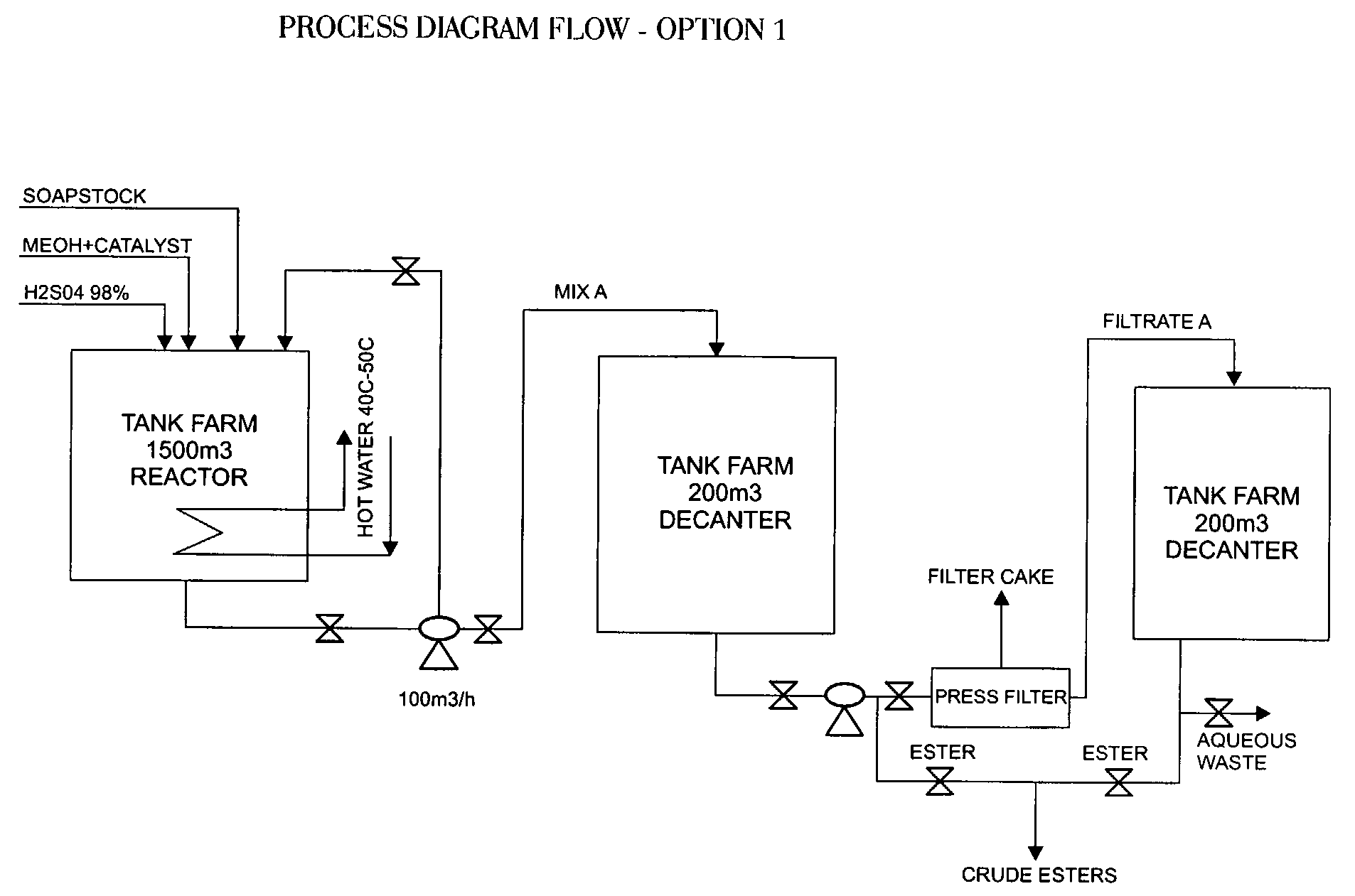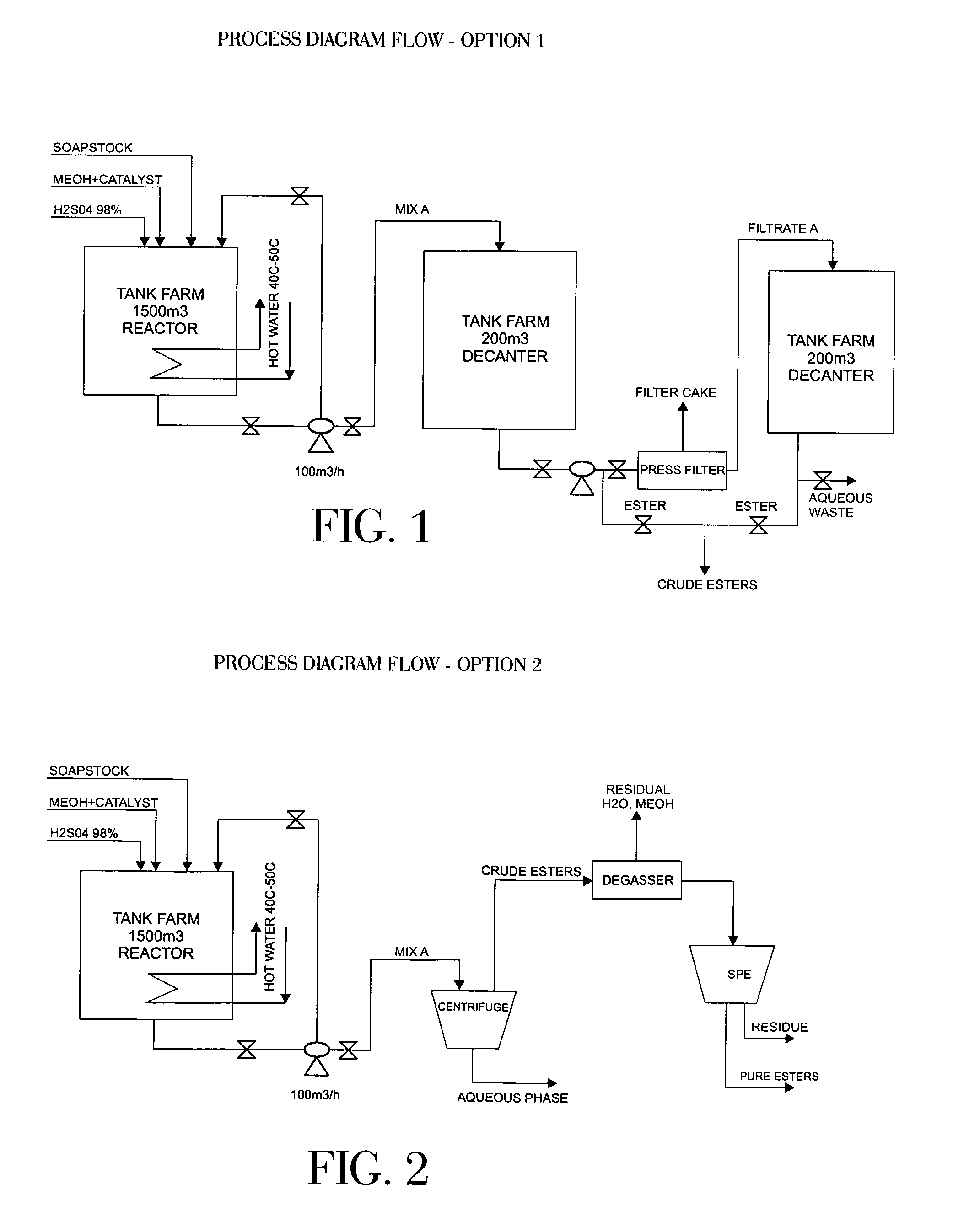Biodiesel Production From Soapstock
a biodiesel and soapstock technology, applied in the recovery of fatty substances, biofuels, fatty oils/acids from waste, etc., can solve the problems of difficult separation of organic crude fatty acids from aqueous phase, dark color crude fatty acids having residual moisture and other lesser impurities, and achieves easy organic separation, reduced interaction, and low viscosity and solidification points
- Summary
- Abstract
- Description
- Claims
- Application Information
AI Technical Summary
Benefits of technology
Problems solved by technology
Method used
Image
Examples
example 1.1
[0095]100 kg of soapstock with 40% of water, fatty part composed by 95.2% of fatty acids as soaps, 1.2% of monoglycerides, 1.5% of diglycerides, 1.1% of triglycerides, and 1.0% of sterols, measured by Gel permeation technique was neutralized with 8.7 kg of sulfuric acid 98% at 45C until PH 4.0. 9.0 kg of Methanol was added followed by 0.03 kg of liquid enzyme CALB—Candida antartica Lipase B from Novozymes. Mixture was kept under circulation using a diafragm pump 100 liter / hour flow rate during 6 days. Initial Acid value for the organic phase was 155 and decreased as described in the Table 1. External temperature ranged 24° C. to 30° C. over the 6 days.
TABLE 1Acid value over 6 daysdaysAV mgkoh / g01541105276361448538632
example 1.2
[0096]Circulation was stopped and mixture was settled out for 8 hours. About 49 kg of crude methyl esters was separated from 68.9 kg of an aqueous phase including a layer of a emulsion. The aqueous phase was filtered out through a press filter producing 11 kg of filtration cake. The filtered liquor was settled down for additional 3 hours separating 2.3 kg of crude methyl esters and 55.6 of a transparent aqueous phase which was discharged to sewer.
[0097]Total amount of crude methyl esters produced was 51.3 kg with AV 25. About 1.8 kg of sodium hydroxide 50% solution was added to neutralize the residual non esterified fatty acids.
[0098]Total amount after neutralization was 53.1 kg of neutralized crude esters for distillation.
example 1.3
[0099]The crude neutralized methyl esters was fed to a lab wiped film evaporator 0.13 ft2 at 1 kg / hour flow rate, still temperature was 220° C. working with 1.5 mmhg of pressure. A degasser 150C@5 mmhq was assembled before the main still to remove residual water coming from the neutralization and methanol.
[0100]Forecut of 40 kg of pure fatty acid methyl esters Gardner 4, AV<2 was produced as a main product. Process yield was 40% in relation to the soapstock and 71% in relation to the total fatty material.
[0101]11.1 kg of a bottom stream having 8% of sterols, partial glycerides, and fatty acid soaps was produced as residue. This material was processed according U.S. Pat. No. 6,281,373 B1 to recover the sterols and the fatty acids as methyl esters again. The bottom stream could also be recycled back to the soapstock storage tank.
PUM
| Property | Measurement | Unit |
|---|---|---|
| pressure | aaaaa | aaaaa |
| pressure | aaaaa | aaaaa |
| temperature | aaaaa | aaaaa |
Abstract
Description
Claims
Application Information
 Login to View More
Login to View More - R&D
- Intellectual Property
- Life Sciences
- Materials
- Tech Scout
- Unparalleled Data Quality
- Higher Quality Content
- 60% Fewer Hallucinations
Browse by: Latest US Patents, China's latest patents, Technical Efficacy Thesaurus, Application Domain, Technology Topic, Popular Technical Reports.
© 2025 PatSnap. All rights reserved.Legal|Privacy policy|Modern Slavery Act Transparency Statement|Sitemap|About US| Contact US: help@patsnap.com


